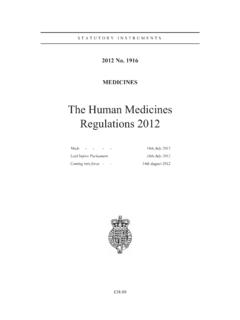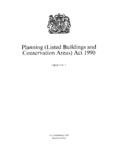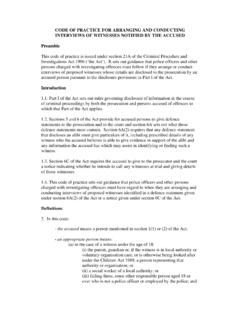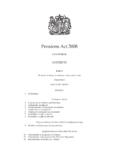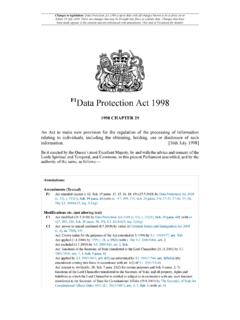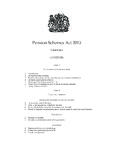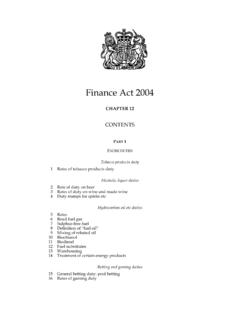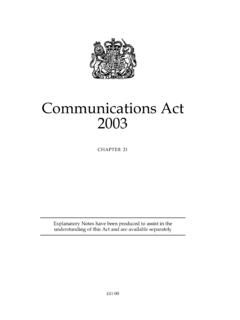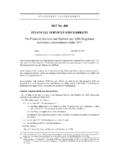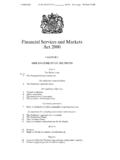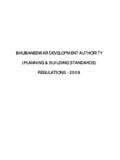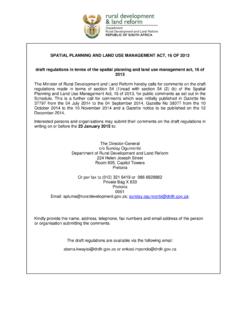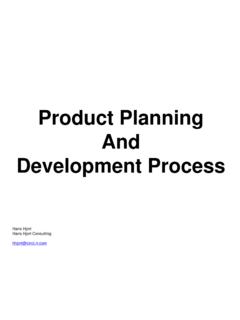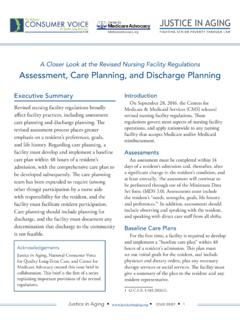Transcription of 2016 No. 332 TOWN AND COUNTRY PLANNING, …
1 S T A T U T O R Y I N S T R U M E N T S 2016 No. 332 town AND COUNTRY planning , ENGLAND The town and COUNTRY planning (General Permitted development ) (England) (Amendment) Order 2016 Made - - - - 10th March 2016 Laid before Parliament 11th March 2016 Coming into force - - 6th April 2016 The Secretary of State, in exercise of the powers conferred by sections 59, 60, 61 and 333(7) of the town and COUNTRY planning Act 1990(a), makes the following Order. Citation and commencement 1. This Order may be cited as the town and COUNTRY planning (General Permitted development ) (England) (Amendment) Order 2016 and comes into force on 6th April 2016. Amendments to the town and COUNTRY planning (General Permitted development ) (England) Order 2015 2.
2 The town and COUNTRY planning (General Permitted development ) (England) Order 2015(b) ( the General Permitted development Order ) is amended as follows. Review 3. After article 7 insert Review 7A. (1) The Secretary of State must from time to time (a) carry out a review of articles 1 to 7; (b) set out the conclusions of the review in a report; and (c) publish the report. (2) The report must in particular (a) set out the objectives intended to be achieved by the regulatory system established by those articles; (b) assess the extent to which those objectives are achieved; and (a) 1990 Amendments have been made to section 59 which are not relevant to this Order.
3 Section 60 was amended by section 4(1) of the Growth and Infrastructure Act 2013 (c. 27). (b) 2015/596. 2(c) assess whether those objectives remain appropriate and, if so, the extent to which they could be achieved with a system that imposes less regulation. (3) The first report under this article must be published before the end of the period of five years beginning with 6th April 2016. (4) Reports under this article are afterwards to be published at intervals not exceeding five years.. Amendment in relation to development within the curtilage of a dwellinghouse 4. In Part 1 of Schedule 2 ( development within the curtilage of a dwellinghouse), in Class A for paragraph (h)(ii) substitute (ii) be within 7 metres of any boundary of the curtilage of the dwellinghouse being enlarged which is opposite the rear wall of that dwellinghouse.
4 Amendment in relation to change of use of shops to financial and professional 5. In Part 3 of Schedule 2 (changes of use), in Class D after building insert and any land . Amendments in relation to change of use of launderettes to dwellinghouses 6. (1) Class M in Part 3 of Schedule 2 is amended as follows. (2) For paragraph M of Class M substitute Class M retail and specified sui generis uses to dwellinghouses Permitted development M. development consisting of (a) a change of use of a building from (i) a use falling within Class A1 (shops) or Class A2 (financial and professional services) of the Schedule to the Use Classes Order, (ii) a use as a betting office, pay day loan shop or launderette, or (iii) a mixed use combining use as a dwellinghouse with (aa) a use as a betting office, pay day loan shop or launderette, or (bb) a use falling within either Class A1 (shops) or Class A2 (financial and professional services) of that Schedule (whether that use was granted permission under Class G of this Part or otherwise), to a use falling within Class C3 (dwellinghouses) of that Schedule, and (b)
5 Building operations reasonably necessary to convert the building referred to in paragraph (a) to a use falling within Class C3 (dwellinghouses) of that Schedule.. (3) For paragraph (1)(d)(i) substitute (i) on adequate provision of services of the sort that may be provided by a building falling within Class A1 (shops) or Class A2 (financial and professional services) of that Schedule or, as the case may be, a building used as a launderette, but only where there is a reasonable prospect of the building being used to provide such services, or . Amendments in relation to change of use of offices to dwellinghouses 7. (1) In Part 3 of Schedule 2, in Class O (a) for paragraph (a) substitute 3 (a) the building is on article 2(5) land and an application under paragraph (1) in respect of the development is received by the local planning authority on or before 30th May 2019; ; (b) omit paragraph (c).
6 (c) for paragraph substitute (1) development under Class O is permitted subject to the condition that before beginning the development , the developer must apply to the local planning authority for a determination as to whether the prior approval of the authority will be required as to (a) transport and highways impacts of the development , (b) contamination risks on the site, (c) flooding risks on the site, and (d) impacts of noise from commercial premises on the intended occupiers of the development , and the provisions of paragraph W (prior approval) apply in relation to that application. (2) development under Class O is permitted subject to the condition that it must be completed within a period of 3 years starting with the prior approval date.
7 ; (d) after paragraph insert Interpretation of Class O For the purposes of Class O, commercial premises means any premises normally used for the purpose of any commercial or industrial undertaking which existed on the date of application under paragraph (1), and includes any premises licensed under the Licensing Act 2003(a) or any other place of public entertainment.. (2) With effect from 31st May 2019 omit (i) article 2(5); (ii) Part 3 of Schedule 1 (article 2(5) land); and (iii) paragraph (a) of Part 3 of Schedule 2 (as substituted by this Order). Amendments in relation to change of use of light industrial to dwellinghouses 8. In Part 3 of Schedule 2, after Class P insert Class PA premises in light industrial use to dwellinghouses Permitted development PA.
8 development consisting of a change of use of a building and any land within its curtilage from a use falling within Class B1(c) (light industrial) of the Schedule to the Use Classes Order to a use falling within Class C3 (dwellinghouses) of that Schedule. development not permitted development is not permitted by Class PA if (a) an application under paragraph (1) in respect of the development is received by the local planning authority on or before 30th September 2017; (b) the building was not used solely for a light industrial use on 19th March 2014 or, in the case of a building which was in use before that date but was not in use on that date, when it was last in use; (a) 2003 4(c) the prior approval date falls on or after 1st October 2020; (d) the gross floor space of the existing building exceeds 500 square metres.
9 (e) the site is occupied under an agricultural tenancy, unless the express consent of both the landlord and the tenant has been obtained; (f) less than 1 year before the date the development begins (i) an agricultural tenancy over the site has been terminated, and (ii) the termination was for the purpose of carrying out development under this Class, unless both the landlord and the tenant have agreed in writing that the site is no longer required for agricultural purposes; (g) the site is, or forms part of (i) a site of special scientific interest; (ii) a safety hazard area; (iii) a military explosives storage area; (h) the building is a listed building or is within the curtilage of a listed building; or (i) the site is, or contains, a scheduled monument.
10 Conditions (1) development is permitted by Class PA subject to the condition that before beginning the development , the developer must (a) submit a statement, which must accompany the application referred to in paragraph (b), to the local planning authority setting out the evidence the developer relies upon to demonstrate that the building was used solely for a light industrial use on the date referred to in paragraph (b); (b) apply to the local planning authority for a determination as to whether the prior approval of the authority will be required as to (i) transport and highways impacts of the development , (ii) contamination risks in relation to the building, (iii) flooding risks in relation to the building, (iv) where the authority considers the building to which the development relates is within an area that is important for providing industrial services or storage or distribution services or a mix of those services (which includes, where the development relates to part of a building, services provided from any other part of the building)
